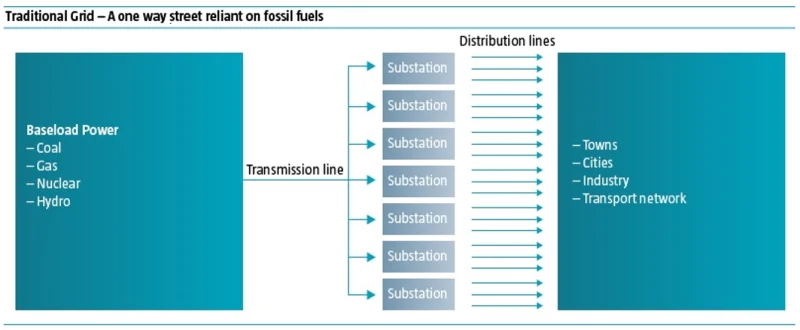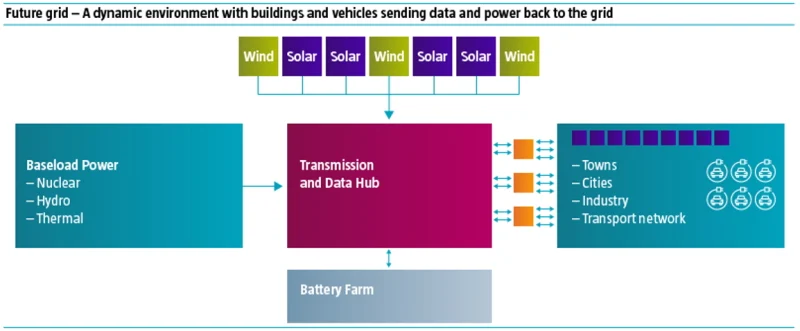The energy crisis happening now in Europe and rippling across the world, in the midst of a record-breaking northern hemisphere drought, is a stark reminder that transitioning from fossil fuels to renewables is necessary from both an environmental and security standpoint. What is less well-known is that the crucial enabler of that transition will be the redesign and rebuilding of electricity grids sophisticated enough to accommodate more distributed power generation, and to dynamically manage demand. The International Energy Agency projects global investment in power grids needs to hit USD 820 billion per year by 2030, up from about USD 260 billion in 2020, if renewable energy projects required to limit global warming to 1.5 °C above pre-industrial levels are to be enabled1.
The current grid is no longer fit for purpose
Existing grid design is based on primarily fossil fuel-powered generation capacity situated in well-chosen strategic locations and flowing one way to consumers. Fossil fuels like coal were plentiful and cheap and it was also manageable as you could switch generating capacity on and off relatively quickly. However, the infrastructure is aging and often unable to efficiently add new distributed supply, cope with extreme weather2, or accommodate new sources of demand like vehicle electrification.

What does the future grid look like?

Future grid design will likely include some element of baseload power like hydro or nuclear that is not weather dependent in the short term. This is then augmented by renewable sources like wind and solar, on a vastly larger scale than currently installed. This will require new and replacement long-distance transmission lines, potentially from remote locations like offshore or desert areas, connecting to hubs that can convert the power to lower voltage for localized distribution.
Additional power will come from what were traditionally points of consumption like houses and factories via interconnectors feeding back into the wider grid. The increased complexity and horizontal integration of the grid will be managed by hubs with direct data transfer from points of consumption, or the 'grid edge'. If the utility has better information on end users' consumption as well as supply, power flows can be optimized in real time. Managing spikes in demand and bringing down peak load will provide immediate benefits in terms of cost and reliability, and help to justify the capex-intensive construction of new power lines.
最新のインサイトを受け取る
投資に関する最新情報や専門家の分析を盛り込んだニュースレター(英文)を定期的にお届けします。
The state of play
Grid development is growing incrementally, as renewable energy sources come onstream, and to replace current aging infrastructure. As this decade progresses we expect more strategic involvement at Federal level in the US and EU level in Europe to build smarter, more efficient and resilient networks. While we have summarized the situation in the big three economic blocks below, the same urgency is driving policy elsewhere. For example, Australian national grid operator Aemo published its blueprint for a future grid3 in 2022, while Japan is redesigning its grid to reach renewable energy goals.4
Europe
Energy policy in Europe is currently in turmoil due to the sudden absence of Russian gas supply and the subsequent extraordinary spike in prices at the margin. Although there is significant short-term panic, and the likelihood of disputes between member states in the winter of 2022/20235, in the medium to long term this crisis is likely to be a positive catalyst for EU-wide integration of future grid development, expanding the ability to transmit power between member states.
China
China aims to significantly increase its power capacity by 2025 to 1.36 times that of 2020, and recognizes the need this creates for making the grid more flexible. Energy security concerns, the rapid addition of new renewable energy projects6 and the need to transfer power from the less populated west of China to the Eastern seaboard, are all factors driving grid investment.
US
Like Europe, the US grid has grown organically without Federal level planning. Recent legislation including the Infrastructure Investment and Jobs Act in November 2021 and the Inflation Reduction Act in August 2022 made some provision for grid investment, but this is far from the level of investment actually required, implying the onus will fall on the private sector. In particular there are no tax credits for transmission lines, and roadblocks to grid infrastructure like state-level planning permits remain a problem.
Future grid technology is already here
The global challenge of climate change has been resistant to technological solutions but the good news is that building the future grid is both practical and possible. Potential investable technologies include:
Next Generation Transmission infrastructure
Companies providing services for transmission line construction, operation and maintenance are anticipating higher order intake to connect new renewable projects to the grid. Due to the current level of underinvestment, the volume of essential construction projects is likely to continue to grow for years to come.
Smart metering
Smart meters provide utilities with actionable information on consumption and operation at the 'grid edge' and provide the end user with real-time feedback, enabling them to make more cost and energy-efficient decisions around consumption.
Existing smart meter manufacturers are also leading in provision of demand management solutions as they are already partners of utilities on the distribution side.
Virtual power plants
A virtual power plant (VPP) refers to a localized electricity grid with its own points of generation, consumption and storage. In an urban context, these might be roof-top solar panels, household appliances and electric vehicles respectively. It is a set of systems that optimizes and automates the generation, flow and consumption of electricity in complex use cases, such as residential areas or industrial sites.
Cybersecurity
Electricity grids are the largest 'cyber-physical' systems in the world, meaning access to the operating software can lead to direct control of physical assets. This is making cybersecurity investment an essential element of grid design and management.
The other facet of the grid that requires cyber safeguards is the electricity market itself. An interesting solution has emerged in Europe, where Transmission System Operators (TSOs) launched a 'crowd-balancing platform' called Equigy7 using private blockchain technology, facilitating the sale of excess electricity.
Conclusion
Building the future grid will take many years, perhaps decades. While some of the investment opportunities around the redesigned grid lie in the future, some companies including engineering and construction businesses, electrical component producers and utilities are already building the new grid brick by brick and cable by cable. These companies can look forward to many years of high and relatively uninterrupted growth, and thus provide investment opportunities right now.
Footnotes
1 https://www.bloomberg.com/news/articles/2022-09-06/world-spending-on-cables-will-have-to-rival-solar-and-wind-power?srnd=green
2 https://www.wsj.com/articles/chinas-scorching-heat-and-hydropower-missteps-test-nations-power-grid-11661514473?
https://www.wsj.com/articles/california-avoids-blackouts-by-texting-convincing-consumers-to-slash-power-use-11662658114?
3 https://www.theguardian.com/australia-news/2022/jun/30/what-australias-power-grid-urgently-needs-for-once-in-a-century-transformation-away-from-fossil-fuels?
4 https://www.reuters.com/world/asia-pacific/japan-considers-doubling-inter-regional-power-grid-boost-renewable-energy-2021-04-16/
5 Poland warns against plans for EU windfall levy on power producers - https://www.ft.com/content/6123bda2-12d7-48ae-a139-efd89f4a1034
6 https://www.bloomberg.com/news/articles/2022-09-13/china-rust-belt-province-plans-87-billion-clean-energy-overhaul
7 https://equigy.com/tso/
重要事項
当資料は情報提供を目的として、Robeco Institutional Asset Management B.V.が作成した英文資料、もしくはその英文資料をロベコ・ジャパン株式会社が翻訳したものです。資料中の個別の金融商品の売買の勧誘や推奨等を目的とするものではありません。記載された情報は十分信頼できるものであると考えておりますが、その正確性、完全性を保証するものではありません。意見や見通しはあくまで作成日における弊社の判断に基づくものであり、今後予告なしに変更されることがあります。運用状況、市場動向、意見等は、過去の一時点あるいは過去の一定期間についてのものであり、過去の実績は将来の運用成果を保証または示唆するものではありません。また、記載された投資方針・戦略等は全ての投資家の皆様に適合するとは限りません。当資料は法律、税務、会計面での助言の提供を意図するものではありません。 ご契約に際しては、必要に応じ専門家にご相談の上、最終的なご判断はお客様ご自身でなさるようお願い致します。 運用を行う資産の評価額は、組入有価証券等の価格、金融市場の相場や金利等の変動、及び組入有価証券の発行体の財務状況による信用力等の影響を受けて変動します。また、外貨建資産に投資する場合は為替変動の影響も受けます。運用によって生じた損益は、全て投資家の皆様に帰属します。したがって投資元本や一定の運用成果が保証されているものではなく、投資元本を上回る損失を被ることがあります。弊社が行う金融商品取引業に係る手数料または報酬は、締結される契約の種類や契約資産額により異なるため、当資料において記載せず別途ご提示させて頂く場合があります。具体的な手数料または報酬の金額・計算方法につきましては弊社担当者へお問合せください。 当資料及び記載されている情報、商品に関する権利は弊社に帰属します。したがって、弊社の書面による同意なくしてその全部もしくは一部を複製またはその他の方法で配布することはご遠慮ください。 商号等: ロベコ・ジャパン株式会社 金融商品取引業者 関東財務局長(金商)第2780号 加入協会: 一般社団法人 日本投資顧問業協会

